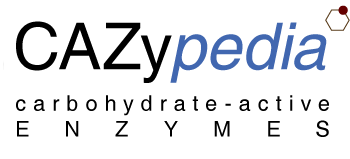1 November 2024: Is this a world record? Six CAZypedia families in one fell swoop! The
CBM47, CBM70, CBM96, CBM105, CBM106 and PL44 CAZypedia pages are now flipped to
Curator Approved status. What do these diverse families from diverse origins with diverse binding specificities have in common? Astonishingly, at least one characterized member from each family interacts with a charged glycan!
Wenwen Tao authored the
CBM47,
CBM96 and
CBM106 pages,
Menghui Sun authored the
CBM70 page,
Guanchen Liu authored the
CBM105 page and
Jinhang Zhou authored the
PL44 page. All this under the responsible curatorship of
Yaoguang Chang.
Dive into these diverse families on their respective CAZypedia
pages: CBM47, CBM70, CBM96, CBM105, CBM106 and PL44!
25 October 2024: Laminariawesome! Check out two new marine families of CBMs, CBM102 and CBM103, now on CAZypedia which have an ecological role in bacterial degradation of laminarin during phytoplankton blooms. Some function as surface glycan binding proteins but others have roles in targeting their appended catalytic modules to substrate. Both pages were authored by Marie-Katherin Zühlke. Read up on these environmentally important CBMs on their respective CBM102 and CBM103 pages!
19 July 2024: Chalk-up one more for the GTs! The Glycosyltransferase Family 47 page joined the small group of Curator Approved Glycosyltransferase Families pages in CAZypedia today. This entry was authored by Ph.D. students Daniel Tehrani and Charlie Corulli, and Curated by Breeanna Urbanowicz with input from Kelley Moremen. Widely represented in plants, GT47 members are anomer-inverting glycosyltransferases, which are involved in the biosynthesis of several cell wall matrix polysaccharides. Representatives from mammals are involved in heparin biosynthesis. Correspondingly, members of GH47 have diverse substrate specificities, including the transfer of both anionic and neutral monosaccharides to polysaccharides. This is a great example where two keen Ph.D. students worked with their supervisors to create a valuable page for the scientific community. We encourage others to follow their lead, on your favorite family!
9 July 2024: Yet another new family of beta-1,2-glucan-active enzymes! Today, Masahiro Nakajima Curator Approved the Glycoside Hydrolase Family 186 page by Sei Motouchi. GH186 is a family of anomer-inverting enzymes from bacteria, members of which are specific for beta-1,2-glucans. Intriguingly, although some GH186 members work as classic glycoside hydrolases, others perform transglycosylation by wrapping the sugar chain around in the active-site, to position the 6-OH group of a terminal glucosyl unit for direct attack. Also notable, GH186 members appear to use an extended chain of water molecules to relay acceptor deprotonation by the general base residue, i.e. a Grotthuss mechanism. Check out the GH186 page to learn more about these interesting enzymes, and make sure to see the GH189, GH144, and GH162 pages from this same group.
2 May 2024: CBDs I to X... A major milestone! CBM families 1 to 10 are now complete! These are the old CBD (cellulose-binding domain) families, which used to have roman numerals as part of their nomenclature. A special thank you to all the authors and responsible curators who have contributed to this major milestone. Go have a peek at each of these old-school families on their respective CAZypedia pages: CBM1, CBM2, CBM3, CBM4, CBM5, CBM6, CBM7, CBM8, CBM9, and CBM10.
